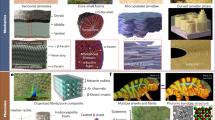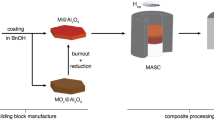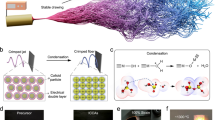Abstract
High strength and high toughness are usually mutually exclusive in engineering materials. In ceramics, improving toughness usually relies on the introduction of a metallic or polymeric ductile phase, but this decreases the material’s strength and stiffness as well as its high-temperature stability. Although natural materials that are both strong and tough rely on a combination of mechanisms operating at different length scales, the relevant structures have been extremely difficult to replicate. Here, we report a bioinspired approach based on widespread ceramic processing techniques for the fabrication of bulk ceramics without a ductile phase and with a unique combination of high strength (470 MPa), high toughness (17.3 MPa m1/2), and high stiffness (290 GPa). Because only mineral constituents are needed, these ceramics retain their mechanical properties at high temperatures (600 °C). Our bioinspired, material-independent approach should find uses in the design and processing of materials for structural, transportation and energy-related applications.
This is a preview of subscription content, access via your institution
Access options
Subscribe to this journal
Receive 12 print issues and online access
$259.00 per year
only $21.58 per issue
Buy this article
- Purchase on Springer Link
- Instant access to full article PDF
Prices may be subject to local taxes which are calculated during checkout




Similar content being viewed by others
Change history
10 November 2017
In the original version of this Article, the R-curves, which quantify how the toughness increases when the crack propagates, were measured following published guidelines (M. E. Launey, Acta Mater. 57, 2919–2932; 2009). Robert Ritchie (Lawrence Berkeley National Laboratory) proposes that the 2013 ASTM E1820 standard (Standard Test Method for the Measurement of Fracture Toughness) is a more appropriate guideline. The authors agree, and have therefore corrected the toughness values in the Article to meet the ASTM standard. Specifically, Figs 3c,j and 4 have been amended and the original toughness values (in MPa m1/2) of 22 (abstract and page 510) and 21 (page 511) have been replaced with 17.3 and 16.4, respectively. For consistency, the following changes have been made. On page 510, the text "By taking into account the local deflection as well as the other dissipation mechanisms with a J-integral, and by using the equivalence in the stress intensity factor, we find that the maximum increase of toughness is extremely high, around 22 MPa m1/2. This corresponds to a 350% increase compared to the KIc toughness (600% increase with respect to the reference alumina)." has been changed to "According to the ASTM criterion, the maximum increase of toughness is extremely high, around 17.3 MPa m1/2. This corresponds to a 300% increase compared to the KIc toughness (500% increase with respect to the reference alumina)." On page 512, the sentence “The unique combination of specific strength ((σf/ρ) and specific toughness (Kc/ρ) of our bioinspired ceramic material actually matches that of engineering aluminium and magnesium alloys (Fig. 4b) while exhibiting higher hardness (16 GPa), stiffness and operating temperature.” has been changed to "The unique combination of specific strength ((σf/ρ) and specific toughness (Kc/ρ) of our bioinspired ceramic material actually matches that of glass-fibre-reinforced plastics (GFRP; Fig. 4b) while exhibiting high hardness (16 GPa), stiffness and operating temperature." On page 513, the following sentence has been removed: "However, toughness measurements can be considered valid until the data becomes geometry dependent due to large-scale bridging37, which here corresponds to Δa=0.8 mm. The values reported here were thus always obtained within a valid range of crack extension." In the caption of Fig. 4, "The nacre-like aluminas have specific strength/toughness properties similar to those of titanium or magnesium metallic alloys" has been changed to "The nacre-like aluminas have specific strength/toughness properties similar to those of GFRP".
References
Ashby, M. F. Materials Selection in Mechanical Design 624 (ASTM International, (2010).
Ritchie, R. O. The conflicts between strength and toughness. Nature Mater. 10, 817–822 (2011).
Koester, K. J., Ager, J. W. & Ritchie, R. O. The true toughness of human cortical bone measured with realistically short cracks. Nature Mater. 7, 672–677 (2008).
Peterlik, H., Roschger, P., Klaushofer, K. & Fratzl, P. From brittle to ductile fracture of bone. Nature Mater. 5, 52–55 (2006).
Barthelat, F. & Rabiei, R. Toughness amplification in natural composites. J. Mech. Phys. Solids 59, 829–840 (2011).
Barthelat, F. et al. On the mechanics of mother-of-pearl: A key feature in the material hierarchical structure. J. Mech. Phys. Solids 55, 306–337 (2007).
Okumura, K. & De Gennes, P. G. Why is nacre strong? Elastic theory and fracture mechanics for biocomposites with stratified structures. Eur. Phys. J. E 4, 121–127 (2001).
Song, F., Soh, A. K. & Bai, Y. L. Structural and mechanical properties of the organic matrix layers of nacre. Biomaterials 24, 3623–3631 (2003).
Meyers, M. A., McKittrick, J. & Chen, P-Y. Structural biological materials: Critical mechanics-materials connections. Science 339, 773–779 (2013).
Bonderer, L. J., Studart, A. R. & Gauckler, L. J. Bioinspired design and assembly of platelet reinforced polymer films. Science 319, 1069–1073 (2008).
Clegg, W. J., Kendall, K., Alford, N. M., Button, T. W. & Birchall, J. D. A simple way to make tough ceramics. Nature 347, 455–457 (1990).
Munch, E. et al. Tough, bio-inspired hybrid materials. Science 322, 1516–1520 (2008).
Erb, R. M., Libanori, R., Rothfuchs, N. & Studart, A. R. Composites reinforced in three dimensions by using low magnetic fields. Science 335, 199–204 (2012).
Deville, S. et al. Metastable and unstable cellular solidification of colloidal suspensions. Nature Mater. 8, 966–972 (2009).
Hunger, P. M., Donius, A. E. & Wegst, U. G. K. Platelets self-assemble into porous nacre during freeze casting. J. Mech. Behav. Biomed. Mater. 19, 87–93 (2013).
Herring, C. Effect of change of scale on sintering phenomena. J. Appl. Phys. 21, 301–303 (1950).
Zaitsev, A., Litvina, A. D., Mogutnov, B. M. & Tsaplin, A. A. Thermodynamic properties and phase equilibria in the system CaO-SiO2-Al2O3 . High Temp. Mater. Sci. 34, 223–231 (1995).
Faber, K. T. & Evans, A. G. Crack deflection processes-I Theory. Acta Metall. 31, 564–576 (1983).
Kolednik, O., Predan, J., Fischer, F. D. & Fratzl, P. Bioinspired design criteria for damage-resistant materials with periodically varying microstructure. Adv. Funct. Mater. 21, 3634–3641 (2011).
Koester, K. J., Ager, J. W. & Ritchie, R. O. The effect of aging on crack-growth resistance and toughening mechanisms in human dentin. Biomaterials 29, 1318–1328 (2008).
Cook, J., Gordon, J. E., Evans, C. C. & Marsh, D. M. A mechanism for the control of crack propagation in all-brittle systems. Proc. R. Soc. A 282, 508–520 (1964).
Dimas, L. S. & Buehler, M. J. Tough and stiff composites with simple building blocks. J. Mater. Res. 28, 1295–1303 (2013).
Launey, M. E. et al. A novel biomimetic approach to the design of high-performance ceramic-metal composites. J. R. Soc. Inter. 7, 741–753 (2010).
Munro, R. G. Evaluated material properties for a sintered alpha-alumina. J. Am. Ceram. Soc. 28, 1919–1928 (1997).
Pavlacka, R., Bermejo, R., Chang, Y., Green, D. J. & Messing, G. L. Fracture behavior of layered alumina microstructural composites with highly textured layers. J. Am. Ceram. Soc. 9, 1577–1585 (2013).
Zhan, G-D., Kuntz, J. D., Wan, J. & Mukherjee, A. K. Single-wall carbon nanotubes as attractive toughening agents in alumina-based nanocomposites. Nature Mater. 2, 38–42 (2003).
Tuan, W. H., Wu, H. H. & Yang, T. J. The preparation of Al2O3/Ni composites by a powder coating technique. J. Mater. Sci. 30, 855–859 (1995).
Travitzky, N., Gutmanas, E. & Claussen, N. Mechanical properties of composites fabricated by pressureless infiltration technique. Mater. Lett. 33, 47–50 (1997).
Prielipp, H. et al. Strength and fracture toughness of aluminum/alumina composites with interpenetrating networks. Mater. Sci. Eng. A 197, 19–30 (1995).
Aghajanian, M. K., MacMillan, N. H., Kennedy, C. R., Luszcz, S. J. & Roy, R. Properties and microstructures of Lanxide Al2O3-Al ceramic composite materials. J. Mater. Sci. 24, 658–670 (1989).
Chen, R., Chiu, Y. & Tuan, W. Toughening alumina with both nickel and zirconia inclusions. J. Eur. Ceram. Soc. 20, 1901–1906 (2000).
Wei, T. et al. The effect of carbon nanotubes microstructures on reinforcing properties of SWNTs/alumina composite. Mater. Res. Bull. 43, 2806–2809 (2008).
Peigney, A., Laurent, C., Flahaut, E. & Rousset, a. Carbon nanotubes in novel ceramic matrix nanocomposites. Ceram. Int. 26, 677–683 (2000).
Yamamoto, G., Omori, M., Hashida, T. & Kimura, H. A novel structure for carbon nanotube reinforced alumina composites with improved mechanical properties. Nanotechnology 19, 315708 (2008).
Liu, J., Yan, H. & Jiang, K. Mechanical properties of graphene platelet-reinforced alumina ceramic composites. Ceram. Int. 39, 6215–6221 (2013).
ASTM E1820-06, Annual Book of ASTM Standards, Vol 0301: Metals—Mechanical Testing; Elevated and Low-Temperature Tests; Metallography (ASTM International, (2006).
Launey, M. E. et al. Designing highly toughened hybrid composites through nature-inspired hierarchical complexity. Acta Mater. 57, 2919–2932 (2009).
Nalla, R. K., Stölken, J. S., Kinney, J. H. & Ritchie, R. O. Fracture in human cortical bone: Local fracture criteria and toughening mechanisms. J. Biomech. 38, 1517–1525 (2005).
National Institute of Standards and Technology. NIST Structural Ceramics Database (SCD) (2002); www.ceramics.nist.gov/srd/scd
Libanori, R., Erb, R. M. & Studart, A. R. Mechanics of platelet-reinforced composites assembled using mechanical and magnetic stimuli. ACS Appl. Mater. Interf. 5, 10794–10805 (2013).
Becher, P. F. Microstructural design of toughened ceramics. J. Am. Ceram. Soc. 74, 255–269 (1991).
Rahaman, M. N., Yao, A., Bal, B. S., Garino, J. P. & Ries, M. D. Ceramics for prosthetic hip and knee joint replacement. J. Am. Ceram. Soc. 90, 1965–1988 (2007).
Wegst, U. G. K. & Ashby, M. F. The mechanical efficiency of natural materials. Phil. Mag. 84, 2167–2186 (2004).
Acknowledgements
We acknowledge the financial support of the ANRT (Association Nationale Recherche Technologie) and Saint-Gobain through a CIFRE fellowship, convention #808/2010. We are indebted to the Centre Lyonnais de Microscopie (CLYM) for access to the FIB microscope. Acknowledgements are due to Guillaume Bonnefont from MATEIS for his assistance on the sintering equipment, and C. Barentin from the ILM for tipping us on the Carbopol to obtain a yield stress suspension.
Author information
Authors and Affiliations
Contributions
S.D. and E.M. designed the research, F.B. processed the sample and performed the mechanical testing, F.B. and S.M. performed the high-temperature mechanical testing, F.B. and B.V.d.M. investigated the structure, all authors analysed and discussed the results, F.B., A.J.S. and S.D. wrote the paper.
Corresponding author
Ethics declarations
Competing interests
The authors declare no competing financial interests.
Supplementary information
Supplementary Information
Supplementary Information (PDF 364 kb)
Rights and permissions
About this article
Cite this article
Bouville, F., Maire, E., Meille, S. et al. Strong, tough and stiff bioinspired ceramics from brittle constituents. Nature Mater 13, 508–514 (2014). https://doi.org/10.1038/nmat3915
Received:
Accepted:
Published:
Issue Date:
DOI: https://doi.org/10.1038/nmat3915
This article is cited by
-
Anisotropic Mechanical Response of Nacre to Heat Treatment Under Indentation: Effect of Structural Orientation
Journal of Bionic Engineering (2024)
-
Mechanical Behavior of Bamboo, and Its Biomimetic Composites and Structural Members: A Systematic Review
Journal of Bionic Engineering (2024)
-
Strong, tough, and thermally conductive nacre-inspired boron nitride nanosheet/epoxy layered nanocomposites
Nano Research (2024)
-
Research progress of biomimetic materials in oral medicine
Journal of Biological Engineering (2023)
-
Strong and tough magnesium-MAX phase composites with nacre-like lamellar and brick-and-mortar architectures
Communications Materials (2023)



